Vanatoo Transparent One Encore Review / Software Update
Build 7.3 | Sound 7.1 | score breakdown
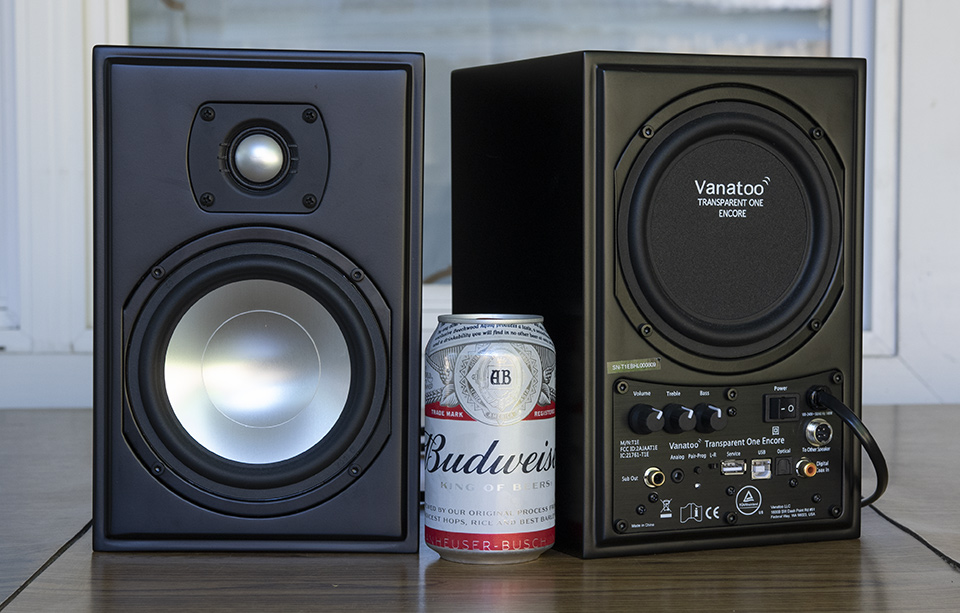
Before we begin the review, I need to discuss the sad state of audio reviews:
I was the first reviewer to get a sample of the Vanatoo Transparent One Encore, and am probably the last to publish.
I sat on the sidelines for 10 months knowing what the speakers sounded like, waiting for Vanatoo to run through the process and produce the fix they promised was coming.
As I waited, I watched almost every reviewer, professional and amateur, get these speakers wrong and misinform their audience. Even as John Atkinson of Stereophile was sending coded messages like "However, a slight gully develops off-axis at the top of the woofer's passband, which might make the Vanatoo sound a touch bright in small rooms or rooms that are not well-damped."
The reviewer writing the article was spouting nonsense like "well-balanced, surprisingly neutral, astoundingly musical."
From the reading and watching I've done, there is only one person who got it right, Zero Fidelity.
Congratulations to him for being the only other reviewer with trained ears and an honest opinion worth a damn.

Honorable mention goes to this couple who were victims of the professional reviewers gross negligence. This FoRealDoe fella and his wife should get a job offer from Stereophile if talent had anything to do with getting a job in this industry.
Doing honest reviews earns not only the trust of my audience, but of the manufacturers who trust my opinions. I don't have the kind of trust most reviewers sell to manufacturers, the kind where nothing bad will ever be written.
I saw this kind of dishonesty on display when I ran into a professional reviewer at Lone Star. He was telling a manufacturer how out of line my write up was, and how he would never write anything bad about a product.
I introduced myself, and asked him why anyone would bother reading his material if he never gave an actual opinion. He talked around it, but never provided anything more than a justification based on his definition of trust.
Now for the reviewers who are trying hard to be honest but don't have the ability to tell a speaker's performance by listening, and lack the knowledge of how a speaker should perform.
Either get a measurement mic and do the work to measure completely and trust the results over your own ears, or stop reviewing because you are misinforming consumers and ruining the hobby I love.
The weight of my reviews are based on my reputation of taking the time, being right, and proving it consistently. My complaints had the weight necessary to start a process that ended up making the Encore a better product. Most manufacturers don't like my style, but they trust I'll be honest. In the first email I sent after plugging in the speakers, I wrote to Gary of Vanatoo, "I don't like the way the speakers sound." I showed measurements, Vanatoo did their own measurements confirmed my issues, and they got a little of the same kind of feedback from John Atkinson of Stereophile. Now the problem is fixed. Customers get better sound, and Vanatoo gets a better product to sell. This is the case that proves the effectiveness and ethics of constructive criticism.
Now, on with the show:
This review took almost a year to complete, but finally came together with a software update that will improve the experience of every current owner, and creates a new standard-bearer for desktop performance.
While I could fill a book with the process, the questions that were answered and ones left unanswered, I will instead review the product as it stands now, massively transformed.
If you already have a pair of Encore speakers, Vanatoo will be releasing the software update on their website soon.
Component Overview:
Tweeter
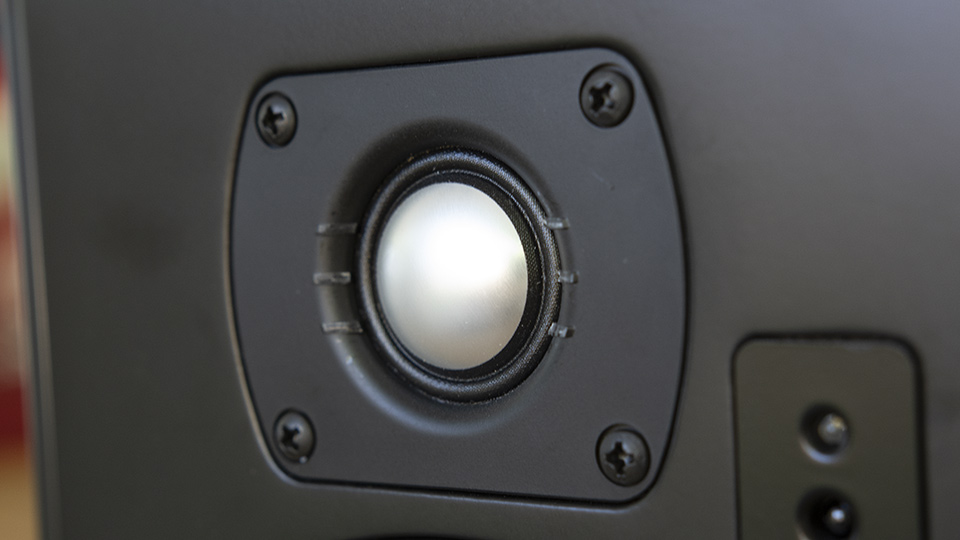
The Encore version of the Transparent One swaps out a gooey soft dome tweeter for this smaller looking, but still 1 inch aluminum foil dome tweeter.
This tweeter is extremely fragile, more than anything else I've worked with, and in many ways the material reminds me of the thin foil used on ribbon tweeters.
As a part of the review process, I ended up cutting the tweeter grills off with wire cutters, and replacing the screws with Parts Express #8 x 3/4" Pan Head Screws.
This cleaned up the treble a bit, but I don't consider this a required tweak. If you attempt this tweak, know that you won't have a warranty, and even the slightest touch of anything to this tweeter will leave a mark if you are lucky, and destroy it if you are not.
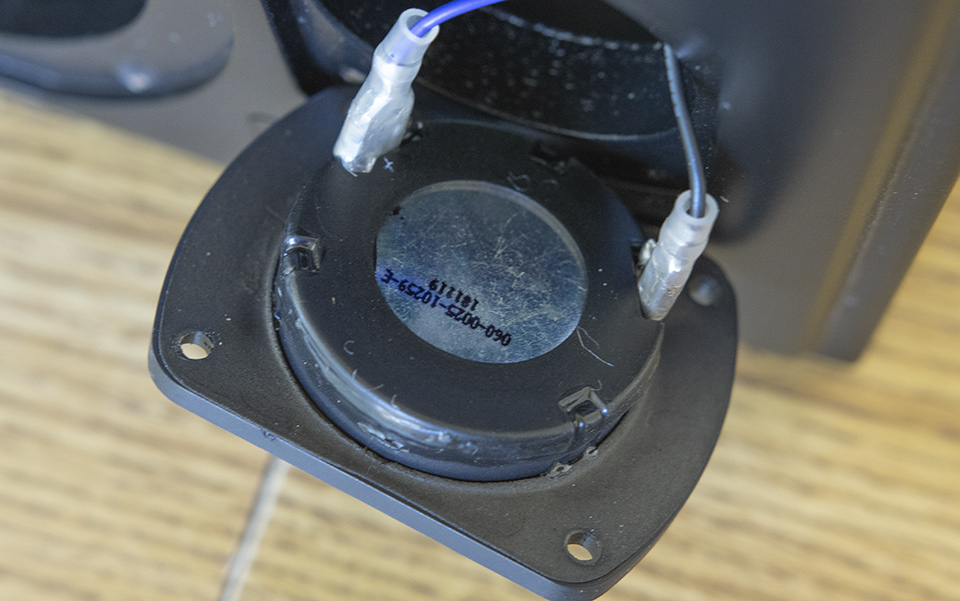
The tweeter is an off the shelf part with a button magnet, glued into a fairly nice looking plastic frame.
Woofer
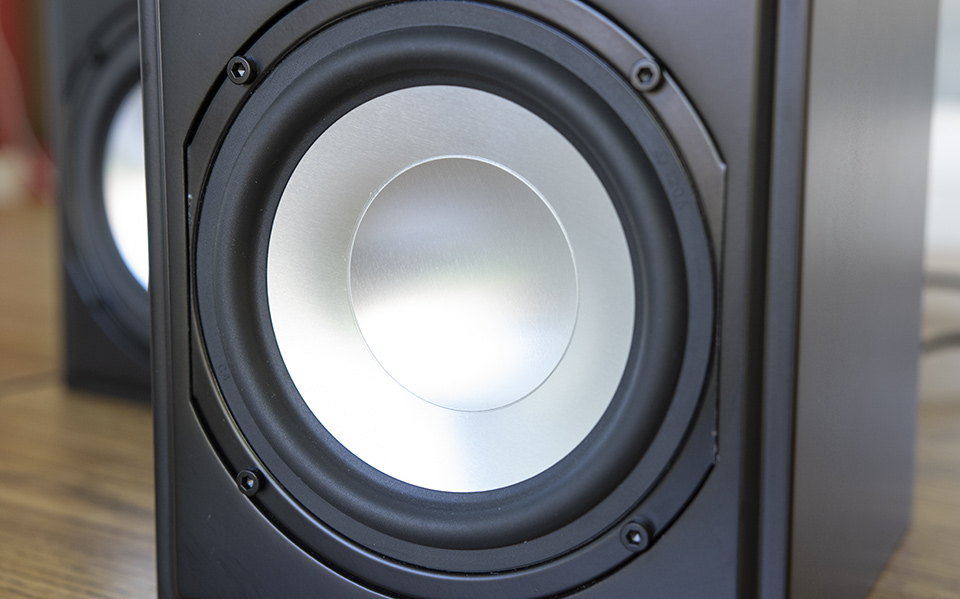
Same woofer as the original, only now with a retarded inverted dustcap. I am assured by Gary over at Vanatoo that because of the size of the woofer and low crossover point, the cap won't matter. He even sent me some extremely detailed measurements of the raw drivers, comparing the old regular duct cap version and the new inverted cap. While the data was helpful in seeing similarities in the response below 2kHz, there was a difference near and above that point. I will remain stubbornly against inverted dustcaps as long as speakers using them continue to have limited dispersion of the lower treble. I consider the matter still up for debate, and welcome any additional data.
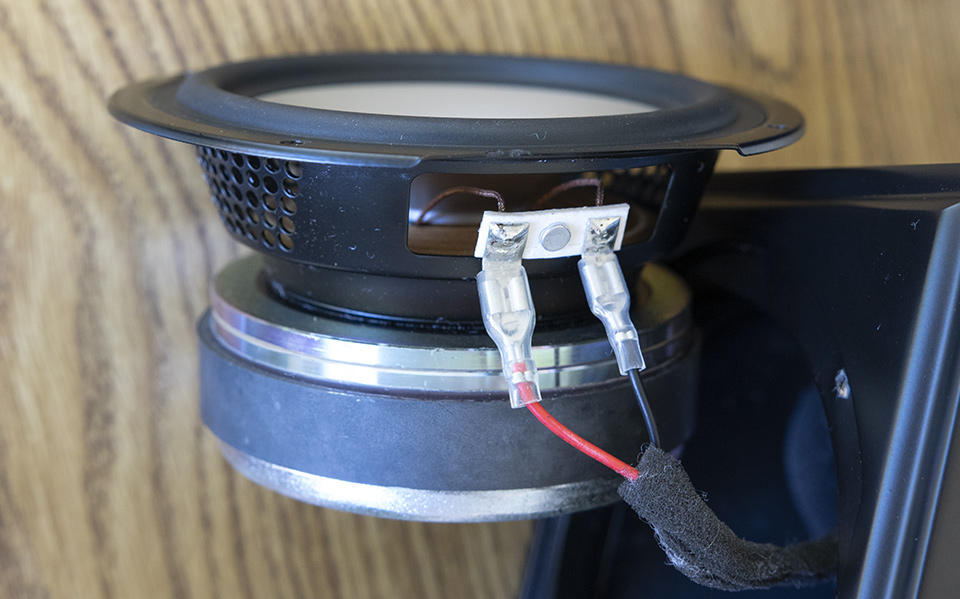
Tensile leads on the back of the woofer look like nice copper. The basket is a bit thin, but this is probably a reasonable cost cutting measure for a custom driver.
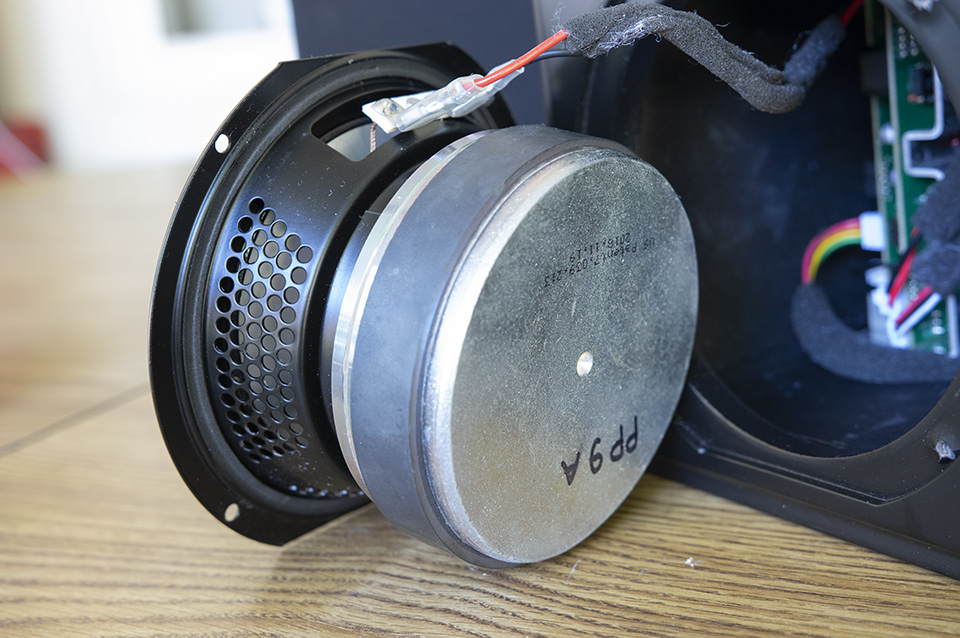
No pole piece vent on the back of the magnet. It's not really a problem as these are not PA speakers, and should not suffer from thermal compression in regular playback. One upside to this choice is that they don't need to worry about sound leaking through the vent.
Passive Radiator
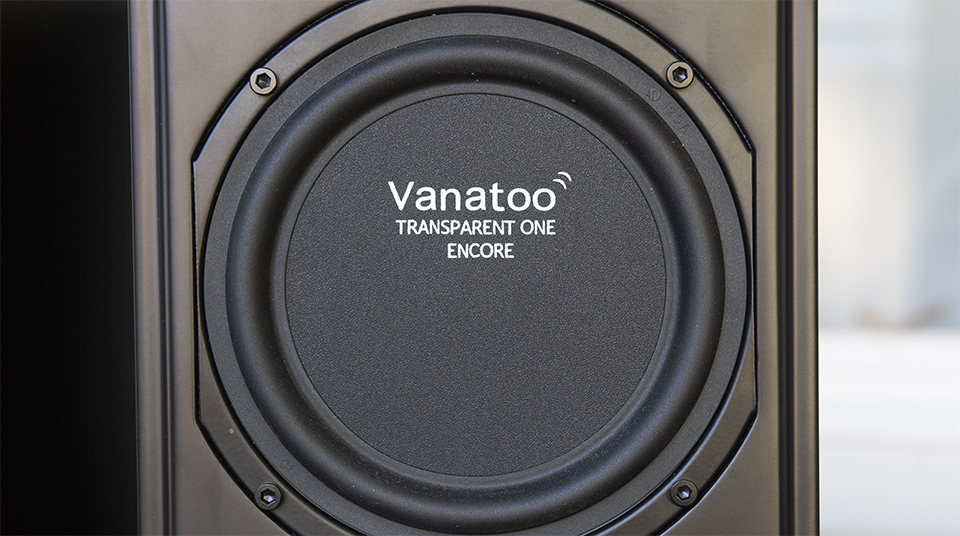
Same design passive radiator, with the only change being the addition of "Encore" stamped on the part.
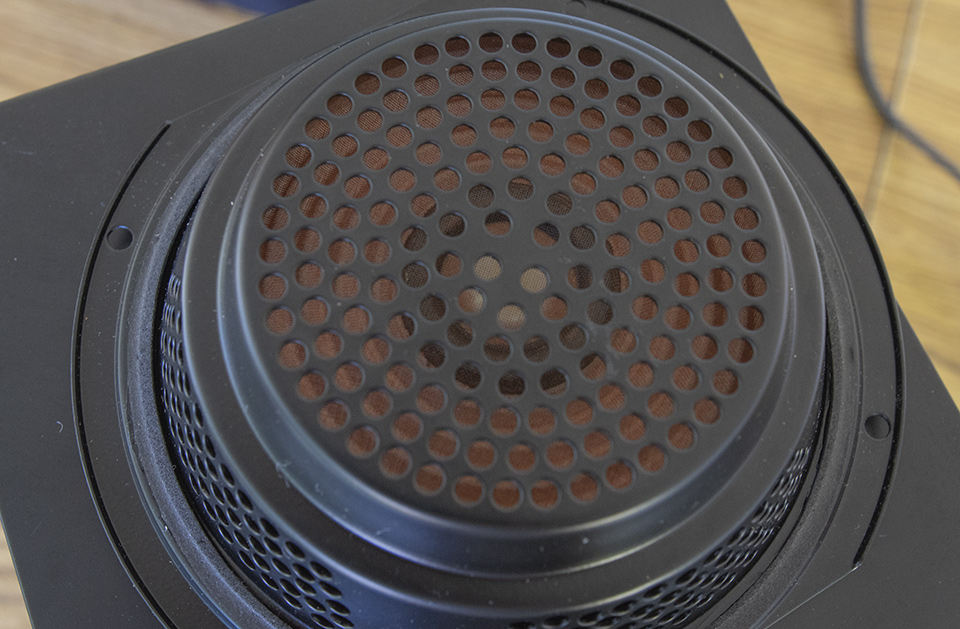
Rear of the radiator shows heavy venting and a nice spider to control the movement.
Grills
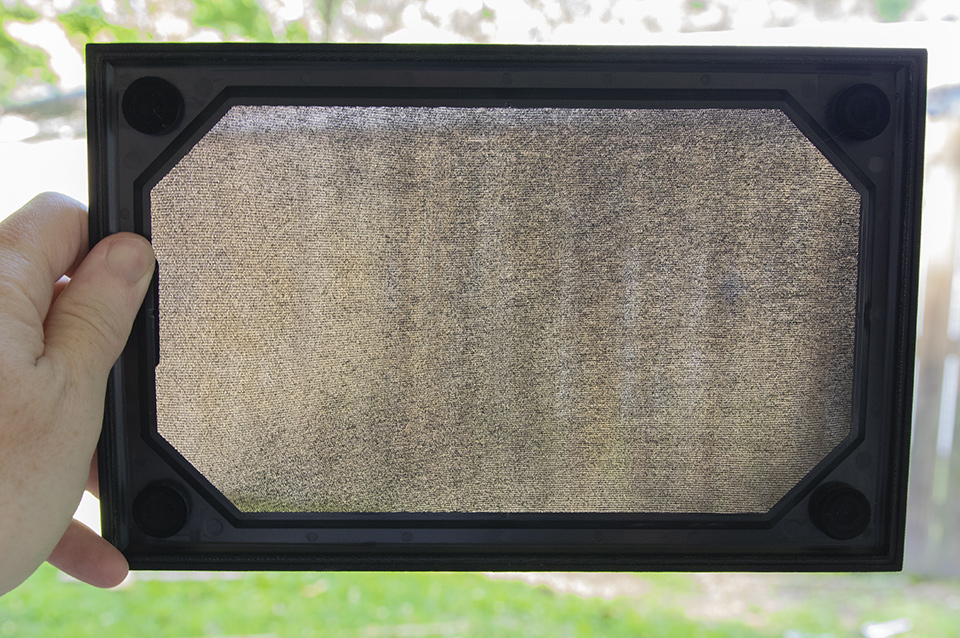
These grills are about as good as grills get. Little magnets click the frames into place and stay put once there. The mesh is a little thicker than I would like, but I only listen to my speakers naked regardless of grill quality.
Input/Output and Controls
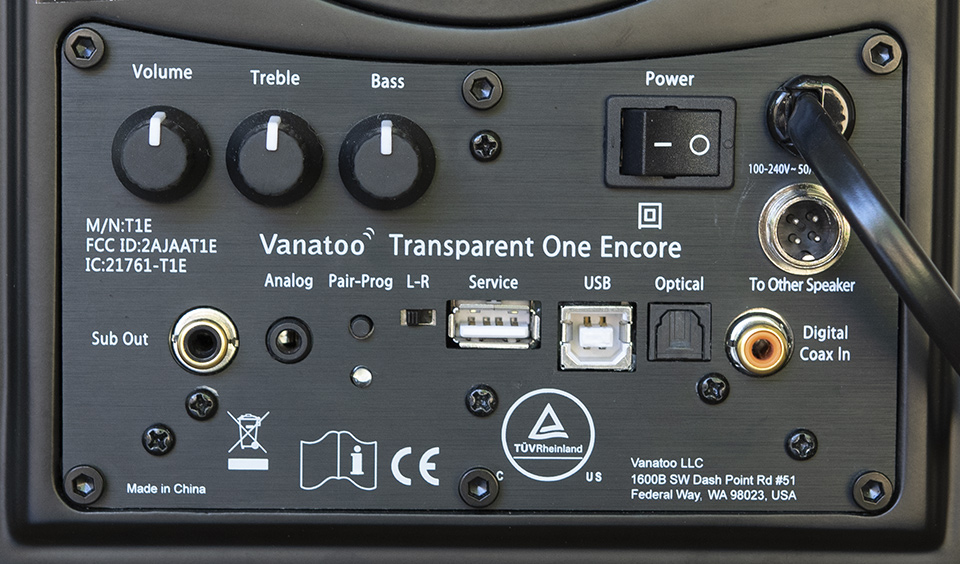
This is the real reason for the Encore version. The feature upgrades for the little Vanatoo Transparent Zero's needed to migrate up to it's larger sibling.
The T1E now has a remote, the same remote as the T0. Also there is a whole new set of secret handshake settings to access the new extra features.
The settings required for best performance are:
Disables sleep mode - otherwise you will have to wait a few seconds for the speakers to turn on.
Enables flat DSP setting mode - Makes bass response flat
Compressors disabled - Not usually an issue, but I'd rather the speaker distort than become tonally out of balance when playing too loud.
The full list of settings and the process for activating them is outlined in the owner's manual.
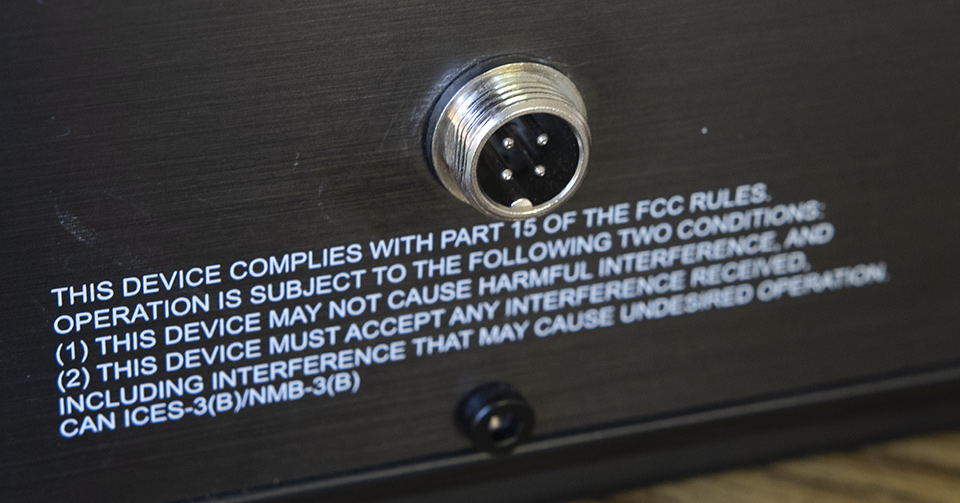
Obviously an area of much debate at the Vanatoo offices, this is now the third method of connecting the two speakers in as many products. I think they all work fine. This one is a DIN type plug with a little cover that screws into the back of the speakers, securing the cable.
Plate Amp
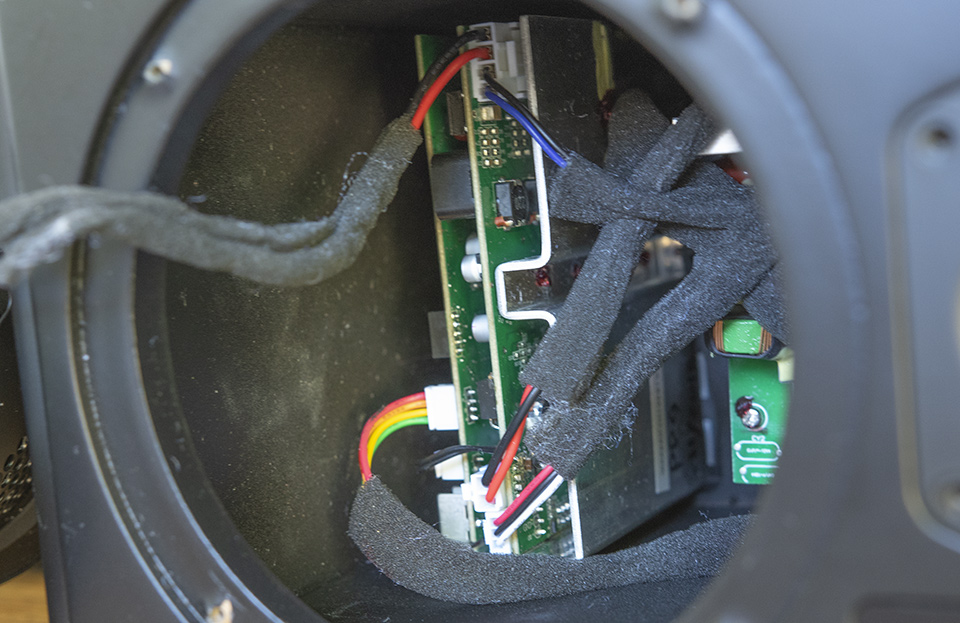
I got bold with these Vanatoos. After chopping up the tweeter grills and disemboweling the speakers, we can have a look at the amp parts inside. This is the input, dsp, and amp board. It's got a chunky heatsink, and some nice tidy wiring coming off of it.
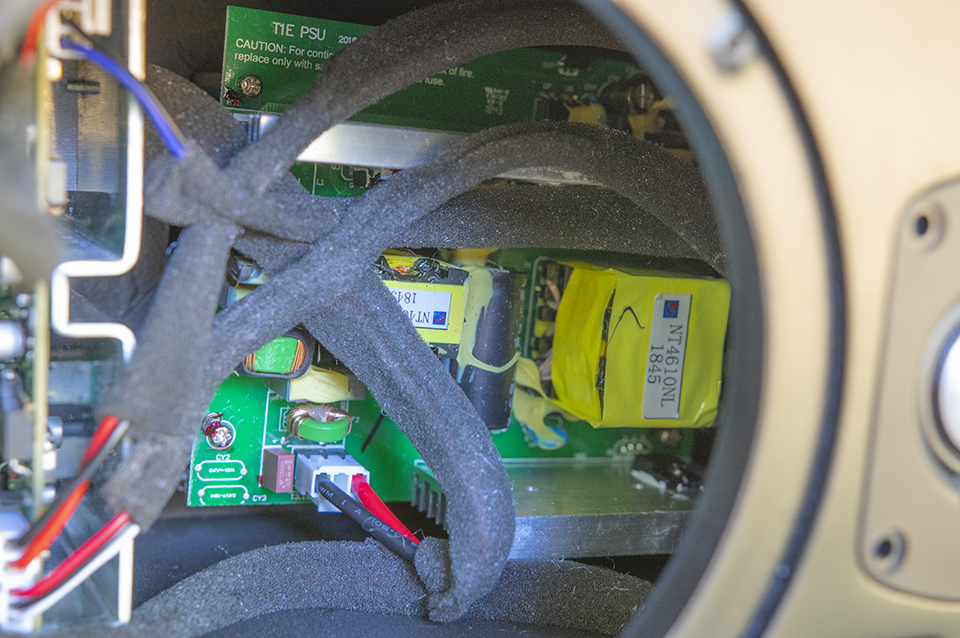
This is the power supply, housed as far away from the music parts of the electronics as possible, and on the other side of the metal heatsink. Looks like very smart stuff in a clean package, big props to Rick.
Crossover
Crossover is now handled in electronics instead of a passive design. They moved from a passive 4th order to an active 6th order - a 36dB/octave slope. This move allows for a lower crossover point, and makes for less inconsistencies between sets of speakers.
Cabinet
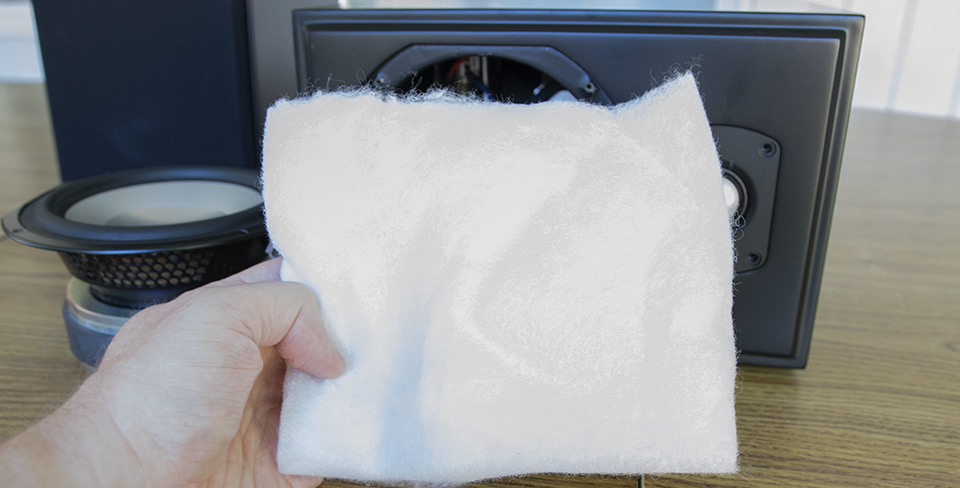
Behold, the tiny polyfill blanket.
Cabinet got no changes in the Encore version, and it's still a nice solidly built speaker with thick MDF.
Desktop setup
I completed the software update and reset all my parameters (flat DSP, no compression, etc). The speakers sound best in my desktop on 7 inch tall stands, 26 inches apart, with only a few degrees of toe-in, and the bass bumped up once with the remote. These speakers are counterintuitive in that if there is too much treble you should increase the toe angle to roll it off.
Listening Notes:
Vanatoo finally has a product that fits the name Transparent One - these are absolute detail/transient retrieval machines.
Good tone and wide dispersion imaging without smearing is extremely rare and potent combination.
The speakers sound good(natural) even when listening from another room - a great test of power response.
With a little setup effort, a T1E owner can get a nearfield sound that is not just enjoyable, but impressive enough to in many ways compete with any full size system I've heard.
This level of performance is what I knew would be possible with the drivers/amp/cabinet, and I'm so happy that Vanatoo made these improvements.
Volume seems to become tonally unbalanced, regardless of the DSP compression settings, at around 95dB nearfield listening to bass heavy music, loud enough for most people.
I don't know anything else on the market that comes close to this quality of audio performance for nearfield desktop systems.
A word of caution
There is a thin line in speaker performance, the one between detail and smoothness in the treble.
This speaker is still a little on the detail side of things, giving a sparkle to the treble and proper shrillness to horns.
The downside is that it will, just like real horns and cymbals cause listening fatigue.
This may come in the form of a headaches or just general aggravation when
listening to certain tracks for extended sessions at higher volume levels. This is not an issue that I normally raise, because honestly this is the first speaker I've reviewed that performs on such a high level while
even approaching the detail side of the line without being unlistenably flawed.
To put this warning into perspective, the speakers original tone was unlistenable to me with way too much treble shrillness giving me headaches within minutes of listening. I can now listen loudly for about 2 hours before I start to have issues.
Measurements:
Let's take a look at what this update actually does to the speakers. It's just an EQ patch, no changes were done to the crossover, so it is easy to spot in measurements.
Measurements above 300Hz were done outdoors on a stand, and the impulse responses were windowed to avoid reflection data. No smoothing is applied to these measurements. Ground plane bass measurements are steady state, and include reflections. 1/48 smoothing is applied to this measurement.
On Axis:
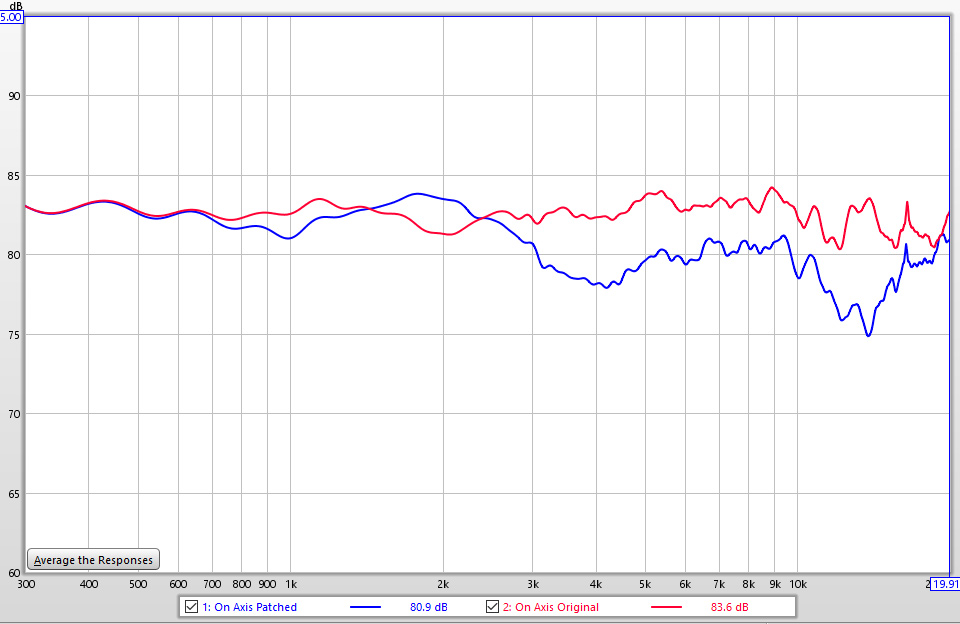
The original prepatch speaker response prioritized on axis performance over all else. With a true +-1dB on axis it would get gold stars with flying colors if this was the only measurement. The updated on axis response is on it's face wonky as can be. We are now +-3.5dB on axis, and got all kinds of wildly placed humps and dips in the midrange and treble.
Off Axis Prepatch:
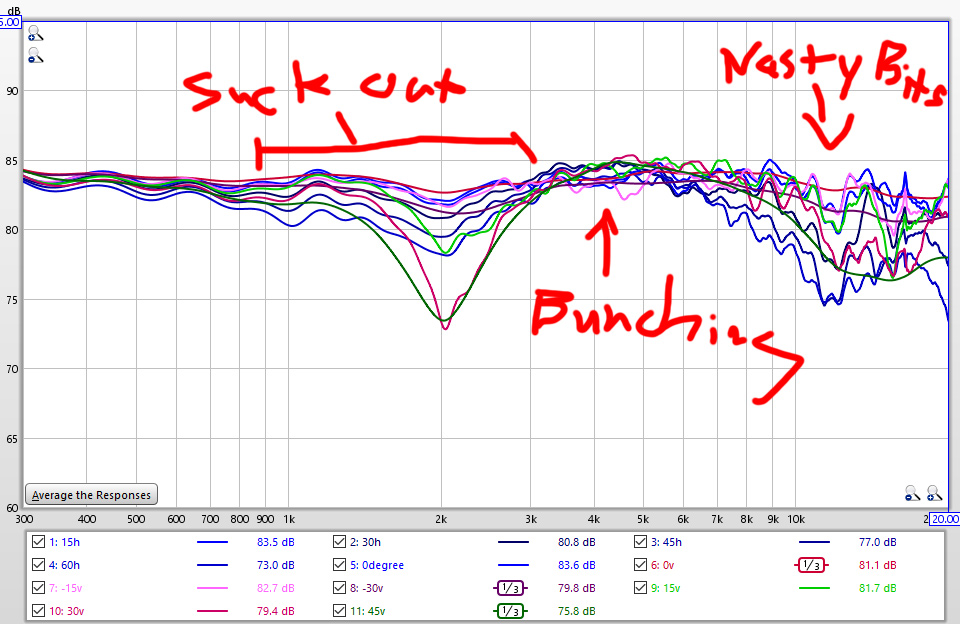
Okay, lets look off axis at the prepatch speaker.
We have suckout from 900Hz to 3kHz, looks crossover related, but could be dispersion of the woofer, or even baffle step from the narrow cabinet. Further up the treble range we have some extreme diffraction based bunching. We are actually louder at 4kHz 45 degrees off axis than on axis. These are some goofy polars from this speaker.
Further up the treble we have some "nasty bits" this is stuff that I was mostly able to clear up with chopping the tweeter grill and replacing the screws.
The real issue is not really the smoothness of the upper treble response, it is that it won't die like a 1 inch tweeter is supposed to die.
The little aluminum foil driver is acting more like a 3/4 inch tweeter and blasting 5-10dB more than a soft dome would off axis in the upper octaves.
Off Axis Patched:
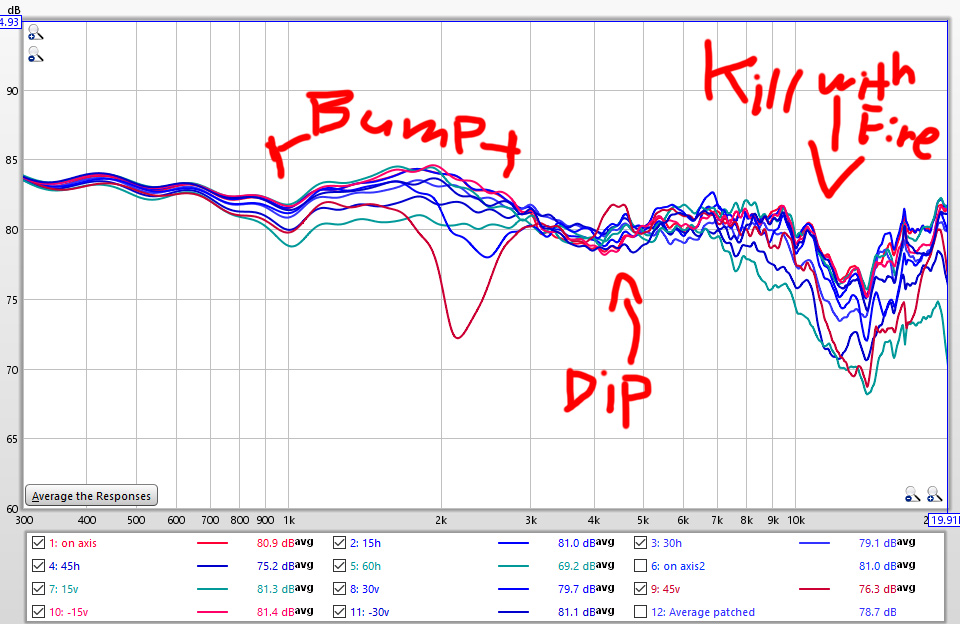
How do you solve these problems? Well you are going to either pick other drivers, redesign the crossover, change the shape of the cabinet, or sacrifice the on axis response to the gods of audio performance.
The last option is what was feasible with a product that had already shipped out the door.
Vanatoo bumped out the off axis dip, and dropped the area that has bunching. Even the nasty bits got kicked down, while still keeping the very highest treble extension.
Averaged Response:
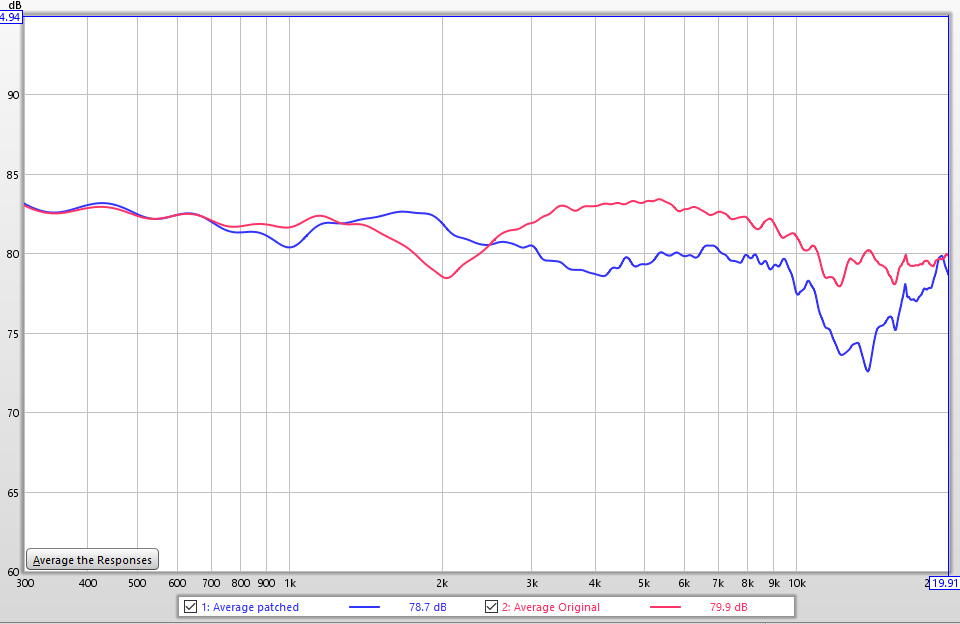
This is more than a listening window average, but less than a full power response. I guess you could call this the front average power response.
On most good speakers this would look like a slow sloping down curvy shaped line.
You can see the issues of the original response laid bare. The fix does not really look particularly attractive, but I am extremely pleased with the sound.
Vanatoo arrived at this EQ fix by doing a full battery of off axis measurements 2.5 degrees at a time, so I'm guessing the new EQ hits whatever target they were trying to reach.
Ground Plane Bass:
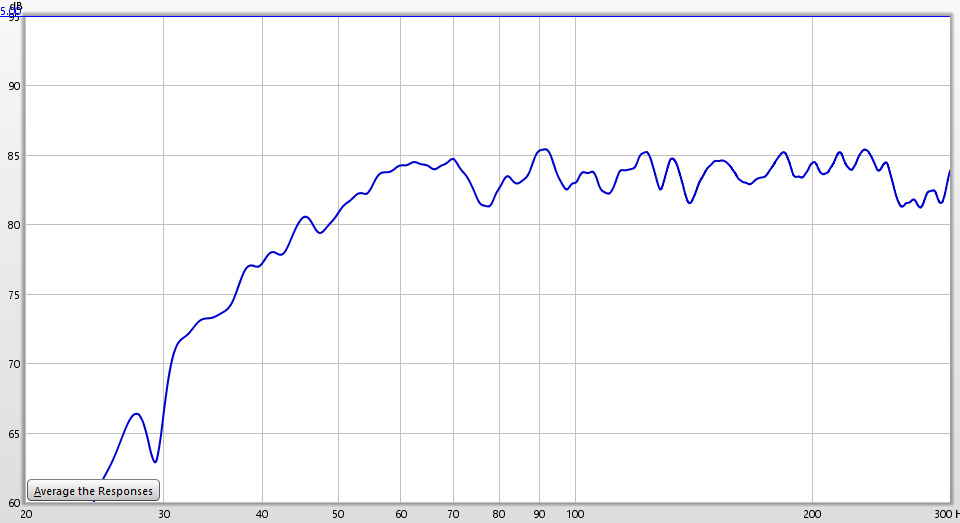
The bass response of the speaker is unchanged. This measurement is in the "Flat DSP" setting, I did not include the default bass response, because it is garbage and no one should be using these speakers without setting them to flat, unless you have a subwoofer hooked up - which I don't recommend for desktop use.
Final Thoughts:

The wonky dispersion pattern of these speaker might give people a bit of hesitation in my evaluation, but there are a multitude of speakers that impress without constant directivity. For example, all planars, electrostats, bipoles, dipoles, and just about every speaker with a baffle width less than 15 inches. The reason why this speaker is uniquely good is because of the overall tonal balance, and the extremely low distortion. The dispersion pattern is in my opinion a blessing. I personally find constant directivity, usually seen on larger horn speakers, to be dry sounding and most require extreme placement scenarios like corner loading to overcome the dead and dull quality of sound they produce.
I stand confidently by my recommendation, and can't wait to hear current owners response to the update, once it becomes available.
Review Scores:
Compare Reviewed Speakers | Scoring Methodology| Build Quality | |
| Tweeter | 5 |
| Woofer | 7 |
| Cabinet | 7 |
| Features | 9 |
| Crossover | 8 |
| Amp | 8 |
| Subwoofer | |
| Score | 7.3 |
| Sound Quality | |
| Neutrality | 7 |
| Bass | 7 |
| Extension | 6 |
| Treble | 6 |
| Midrange | 8 |
| Headroom | 5 |
| Dispersion | 8 |
| Detail | 10 |
| Imaging | 8 |
| Score | 7.1 |
Click here to buy the Vanatoo Transparent One Encore Speakers
Other content you may like:
- Vanatoo Transparent One Review - Software update brings new standard of performance!
- Lone Star Audio Fest 2018 - Staying up late, drinking too much, smoking like chimneys!
- Andrew Jones goes back the be begining, ELAC B5.2 Debut 2.0 Review is up!
- New Scores for all reviewed speakers - Compare and sort for fun!
- Creative Sound Solutions DIY Solution for the high end - CSS Criton 1TD v2 review is up!
- Dayton Makes a Budget Desktop speaker with a crossover - Dayton Audio MK402 review is up!
- Smaller than small, deeper than deep - iLoud Micro Monitor review is up!
- Vanatoo's new speaker, The Transparent Zero review is up!
- SVS Prime Bookshelf Review is now available for your viewing pleasure
- ELAC A-Stock UB5 Listening Impressions are up!
- 30 years in the making, the ancient Bose 901 finally gets measured - The Bose 901 review is up!
- Lock and load, we are hitting the bottom of the barrel with both barrels - The Logitech z313 review is up!
- Bulletproof speakers... No, it's just the B&W 686 S2 Review!
- Declare independence from the British sound! - The KEF Q300 review is up!
- Recommended System Finder - Just in time for the Holidays!
- JBL LSR308 Studio Montor - Super Massive Epic Review!
- Two years after starting this site I finally get around to talking about my stereo.
- Small and cheap speakers transform into retarded and good... Micca COVO-S Review!
- AMT tweeter on a B652? The Dayton B652-AIR is reviewed for great justice!
- JBL LSR305 Studio Monitor Review!
- Zu Essence Review!

